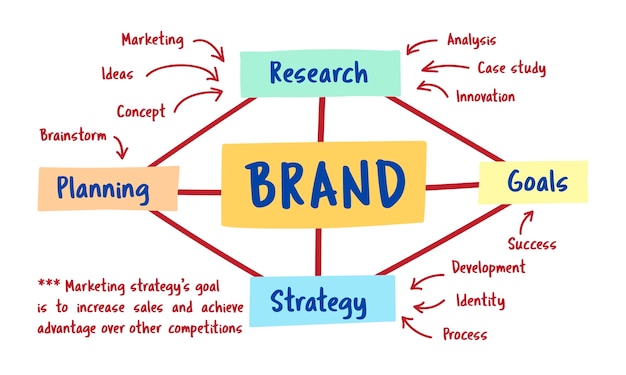The Components of Brand Perception
The Importance of Brand Perception
Strategies for Building and Enhancing Brand Perception
Brand perception is one of the most influential factors that can make or break a company’s success in the ever-evolving landscape of business and marketing,
How consumers perceive a brand significantly impacts their purchasing decisions, loyalty, and overall relationship with the brand.
It encompasses the thoughts, feelings, and opinions consumers form based on their interactions, experiences, and exposure to a brand’s identity, reputation, and messaging.
In this article, we will explore the multifaceted nature of brand perception, its key components, and the importance it holds for businesses.
We will delve into strategies for building and enhancing brand perception, examining how consistent messaging, exceptional customer experiences, and proactive reputation management can shape consumers’ perception of a brand.
The Components of Brand Perception

Brand perception is a multifaceted concept that comprises several key components.
These components collectively shape how consumers perceive and evaluate a brand.
Understanding these components is essential for businesses seeking to manage and improve their brand perception effectively.
Let’s explore the key components of brand perception:
Creating a Strong Brand Image

Brand image refers to the overall impression and associations that consumers have with a brand.
It is shaped by various factors such as brand identity, visual elements (logo, colors, typography), messaging, and the brand’s reputation.
Companies invest significant resources in creating a positive and consistent brand image to establish trust, differentiate themselves from competitors, and evoke desirable emotions in consumers.
The Influence of Brand Reputation

Brand reputation is a vital aspect of brand perception.
It represents the collective opinions, experiences, and perceptions that consumers have developed over time regarding a brand’s products, services, and business practices.
A strong brand reputation can enhance customer trust, attract new customers, and foster loyalty.
However, negative experiences or controversies can severely damage a brand’s reputation and undermine its standing in the market.
Crafting a Distinctive Brand Identity

Brand identity refers to the unique set of visual and verbal elements that represent a brand.
It includes the brand’s name, logo, tagline, and other brand assets.
A well-crafted brand identity communicates the brand’s values, personality, and positioning, helping consumers identify and differentiate it from competitors.
Consistency in brand identity across various touchpoints reinforces brand recognition and fosters a sense of familiarity and trust among consumers.
Shaping Positive Brand Experiences

Brand experience encompasses every interaction and encounter that consumers have with a brand.
It encompasses both pre-purchase and post-purchase experiences, including customer service, product quality, packaging, website usability, and more.
Positive brand experiences can generate customer satisfaction, build loyalty, and lead to positive word-of-mouth recommendations.
On the other hand, a poor brand experience can result in negative perceptions and drive customers away.
The Importance of Brand Perception

Brand perception directly influences consumer behavior.
Consumers form opinions and make purchasing decisions based on how they perceive a brand.
Positive brand perception leads to increased trust, higher willingness to pay, and repeat purchases.
It can also attract new customers through positive word-of-mouth and referrals.
Conversely, negative brand perception can result in lost sales, decreased customer loyalty, and a tarnished reputation.
Competitive Advantage and Differentiation

In today’s crowded marketplace, brand perception can serve as a source of competitive advantage.
A well-regarded brand can stand out from the competition, command premium pricing, and maintain customer loyalty even in the face of similar offerings.
Strong brand perception enables companies to differentiate themselves and build a sustainable position in the market, mitigating the impact of price-based competition.
Crisis Management and Resilience

Brand perception becomes especially crucial during times of crisis.
Whether it’s a product recall, a public relations disaster, or a global pandemic, a well-established positive brand perception can help companies weather the storm.
A strong foundation of trust and goodwill built over time can facilitate forgiveness, minimize the impact of negative events, and aid in the recovery process.
Nurturing Positive Brand Perception

Brand perception is a powerful force that can make or break a business.
It encompasses various elements such as brand image, reputation, identity, and experience, all of which contribute to how consumers perceive and engage with a brand.
Nurturing a positive brand perception requires a strategic and holistic approach, involving consistent messaging, excellent customer experiences, and proactive reputation management.
Strategies for Building and Enhancing Brand Perception
Consistent Brand Messaging

Crafting a clear and compelling brand message that aligns with the brand’s values, purpose, and target audience is essential.
Ensure that the message is consistently communicated across all marketing channels, including advertising, social media, and customer interactions.
Deliver Exceptional Customer Experiences

Invest in providing outstanding customer experiences at every touchpoint.
Focus on exceeding customer expectations, addressing their needs, and resolving issues promptly and efficiently.
Positive interactions create a lasting impression and contribute to a favorable brand perception.
Build Brand Advocacy

Encourage satisfied customers to become brand advocates by leveraging testimonials, case studies, and user-generated content.
Engage with customers on social media platforms, respond to their feedback, and create opportunities for them to share their positive experiences with others.
Measure Brand Perception and Respond to Feedback

Actively listen to customer feedback through surveys, online reviews, and social media mentions.
Use this feedback to identify areas for improvement, address concerns, and continuously enhance the brand’s offerings and customer experience.
Improve Brand Perception

Proactively manage your brand’s online reputation by monitoring online conversations, addressing negative reviews or comments promptly and professionally.
Similarly, actively engage in reputation-building activities such as thought leadership, community involvement, and corporate social responsibility initiatives.
Leverage Influencers and Thought Leaders

Collaborate with influencers and thought leaders who align with your brand values and target audience.
Their endorsement and support can help amplify your brand message and reach a wider audience.
Authentic partnerships with influencers can build credibility, trust, and positively impact brand perception.
Collaborate with Influencers and Brand Ambassadors

Partner with influencers and brand ambassadors who align with your brand’s values and target audience.
The endorsement and support of influencers can have a profound effect on brand perception, drawing in new customers and influencing their perception of the brand.
Adapt to Evolving Consumer Needs

Stay attuned to changes in consumer preferences, market trends, and societal values.
Continuously adapt your brand positioning, messaging, and product offerings to remain relevant and resonate with your target audience.
Deliver on Brand Promises

Consistently deliver on the promises made by your brand.
Ensure that your products and services live up to the expectations set by your marketing efforts.
Building trust through consistent delivery strengthens brand perception.
Prioritize Online Reputation Management

In today’s digital age, online reputation management is crucial.
Monitor and actively manage your brand’s online presence, addressing customer feedback, reviews, and comments promptly and professionally.
Engage with customers on social media, respond to their inquiries, and showcase your commitment to customer satisfaction.
Proactive reputation management can mitigate negative sentiment and protect your brand’s perception.
Continuously Innovate and Improve

Stay ahead of market trends and evolving consumer needs by continuously innovating your products, services, and customer experiences.
Regularly seek customer feedback through surveys, focus groups, and social listening to identify areas for improvement.
By demonstrating a commitment to innovation and addressing consumer pain points, you can enhance brand perception and stay relevant in the marketplace.
Improving brand perception requires a comprehensive and strategic approach.
In conclusion, by defining a clear brand identity, delivering exceptional customer experiences, nurturing brand advocates, leveraging influencers, managing online reputation, and continuously innovating, businesses can create a positive brand perception that resonates with consumers.
Creating Positive Brand Associations for Long-Term Success

Brand associations are the mental connections and attributes that consumers link to a brand.
However, these associations are formed through various touchpoints, including advertising, product experiences, endorsements, and cultural context.
In conclusion, positive brand associations play a crucial role in shaping consumer perception and building a strong brand identity.
Identifying Strengths and Weaknesses

Conduct a thorough analysis of existing brand associations to identify strengths and weaknesses.
However, this involves assessing consumer perceptions, conducting market research, and gathering feedback.
In conclusion, mapping brand associations helps businesses understand how their brand is currently perceived and identifies areas for improvement.
Delivering Excellence

Additionally, delivering exceptional product quality and customer experiences is essential for creating positive brand associations.
However, consistently meeting or exceeding customer expectations helps build trust and reinforces positive brand perceptions.
In conclusion, focus on providing value, reliability, and innovation to establish a reputation for excellence.
The Role of Design

Visual elements such as logos, colors, typography, and packaging play a crucial role in shaping brand associations.
Ensure that your visual identity aligns with the desired brand associations and effectively communicates your brand’s values and personality.
In conclusion, design elements should evoke the desired emotions and resonate with your target audience.
Conclusion
Brand perception is a complex and dynamic concept that holds significant power in shaping consumer behavior and influencing a company’s success.
However, by understanding the components of brand perception and employing strategic initiatives to enhance it, businesses can build a positive brand image, foster customer loyalty, and gain a competitive edge in the marketplace.
In conclusion, consistency, exceptional experiences, and proactive reputation management are key to nurturing a strong and favorable brand perception that resonates with consumers and creates long-term success.
If you liked this article, consider reading another about Brand Audit here.
FAQ
Brand perception surveys provide valuable insights into how consumers perceive a brand, allowing businesses to gather feedback and identify areas for improvement.
By analyzing survey responses, businesses can uncover strengths, weaknesses, and opportunities to enhance their brand’s image, reputation, messaging, and customer experiences.
These surveys enable businesses to make informed decisions and develop strategies that align with consumer expectations, ultimately leading to improved brand perception and increased customer loyalty.
Online Freelance Platforms: Websites like Upwork, Freelancer, and Fiverr provide a platform for connecting with freelancers and professionals in different fields who can collaborate on your project.
Professional Networking Platforms: LinkedIn is a popular platform where professionals from various industries connect.
You can utilize its search and messaging features to find and reach out to potential collaborators with relevant skills and expertise.



